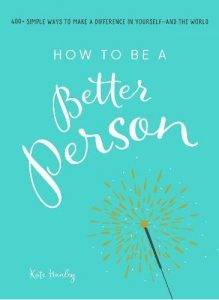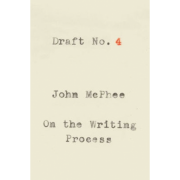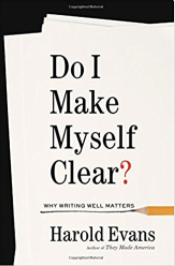 Are you looking for tips to help you write or blog more frequently? Some of the tips from the “Work Well” chapter of Kate Hanley’s How to Be a Better Person may help.
Are you looking for tips to help you write or blog more frequently? Some of the tips from the “Work Well” chapter of Kate Hanley’s How to Be a Better Person may help.
1. Mono-task one thing a day
This is one of my favorite tips. Hanley says:
Multitasking is a fact of life and can sometimes be useful, but it’s not always the best choice. When you work on the most important thing on your daily to-do list, invite your best thinking by closing your email program, putting your phone on airplane mode, blocking yourself from social media, and doing one thing. You’ll get it done more effectively and efficiently when you do.
This works well for me. I’ve cranked out many of my blog posts writing on a steno pad on vacation, as I’ve discussed in “No batteries required: My favorite blogging technique.”
2. Make a learning plan
“If you want your career to continue to grow, you need your skills and interests to keep evolving too. Ensure your growth by making a plan to keep learning,” says Hanley.
I offer some learning tips for writers in “Confessions of a lousy writer—and 6 tips for you.” Also, I offer a financial blogging class.
3. Delegate better
You don’t need to prepare every part of your blog post, article, or white paper yourself. Outsource the parts that aren’t the best use of your time. That’w what I do with the images and tricky formatting of my blog posts.
When you do outsource, don’t micromanage the person who’s doing the work for you. Hanley says to tell the person to “ask for help if the person gets stuck, but otherwise, let them at it. People who are doing something for the first time may make mistakes—focus on appreciating the effort more than the results at first and give positive feedback they can hear.”
4. Take on uncomfortable tasks
Are you scared to write a kind of article or other publication for the first time? Give it it a go.
Hanley says, “Accept your missteps and view them as ways to refine your skills. Growth can be uncomfortable, but so is staying in the same place for too long.”
5. Get better at prioritizing
You can’t do everything. You’ll just drive yourself crazy if you try to do it all.
Hanley says,
Here are some guidelines for setting priorities in a way that helps you focus on the important instead of merely the urgent: Think about the things on your list that make the biggest impact and that mean the most to you—those are your highest priorities. Next come the things that have a big impact, even though you may not love them. For things that don’t move the needle and that you don’t enjoy, either delegate them or bang them out in one concentrated burst.
6. Work smarter, not harder
Identifying your priorities, as suggested in Tip #5, will help you to work smarter instead of harder.
Hanley says,
The eighty/twenty rule—otherwise known as the Pareto principle for the late nineteenth-century economist Vilfredo Pareto who noticed that 80 percent of the land in Italy was owned by 20 percent of the people—says that 80 percent of your results comes from 20 percent of your efforts. Spend some time thinking about the simple actions that, when done consistently, result in big strides toward your goals—strengthening relationships with the 20 percent of your clients who generate 80 percent of revenue, for example, or making sure you get ninety minutes (approximately 20 percent of an eight-hour day) of focused time to produce your best work (no meetings or Facebooking allowed). Now make sure you prioritize those needle movers when planning what you’ll get done in a day or a week. Small, meaningful steps taken with consistency can take you everywhere you want to go.
7. Make time for your soul work
Hanley says,
Every job comes with a long list of responsibilities, but you have an obligation to do the work that speaks to your soul too, even if it doesn’t show up anywhere on that list. When you plan your week, make sure to block out a chunk or two of time that you can devote to the work that’s speculative—the proposal for the new project, or even the art you create on the side that keeps you a passionate and engaged person—because that energy will spill over into the narrower confines of your “job,” too.
Blogging is soul work for me. I do it because I enjoy it more than I do it for an ROI measured in dollars and cents.
Disclosure: If you click on an Amazon link in this post and then buy something, I will receive a small commission. I provide links to books only when I believe they have value for my readers.

Learn more about my financial blogging class!







